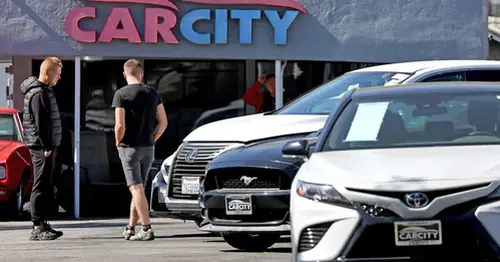
Inflation is finally slowing down, but consumers are still feeling the sting of high prices
As consumer price growth continued its slowdown in May, some are asking whether it could mean the American economy is on the rebound.
The Bureau of Labor Statistics reported Tuesday that the inflation rate fell to 4%, the lowest level it has reached since March 2021 when the inflationary spike began. That news comes as unemployment has remained relatively flat for months and gas prices sit at just under $3.60 per gallon nationally, according to AAA.
While the news is encouraging and it’s a far cry from June of last year, when inflation climbed above 9% and a gallon of gas cost more than $5, economists say the current situation still signals a mixed bag for the U.S. economy.
“It’s not as bad as it seemed before, and it’s not as normal as it seems now,” said Jason Furman, an economist at Harvard University who chaired the Council of Economic Advisers during the Obama administration.
Furman and other economists said the headline inflation has come down dramatically, which is good news. But if food and energy costs — which are particularly volatile and known to fluctuate — are removed from the data, they noted the inflation rate on a monthly basis remained stubborn, rising by 0.4% or more, the same as it did the month before.
Moody’s Analytics economist Bernard Yaros said used automobile prices are the key item holding that rate in place, as they increased 4.4% for the second month in a row. In the good news bracket: Costs for shelter, new vehicles, airfares, jet fuel prices and rental cars all declined, landing between 0.1% and 3%.
But Yaros said most Americans don’t note the nuances of these shrinking inflation rates because it does not clearly affect their pocketbooks. Instead, they look at the totality of their costs, whether they’re shopping at the grocery store, filling their gas tank or buying a new pair of shorts for the summer months.
May CPI report indicates inflation continues to slow
June 13, 202304:35“If you just look at the level of prices … those are still significantly higher compared to what their pre-pandemic trend was,” Yaros said. “I think that’s what’s really bothering Americans even though the rate of change is slowing.”
In some ways, Yaros said, inflation is a messaging issue. Declining costs, like flagging gas prices last month, are beneficial because it reduces the consumer expectation of inflation. The reason rising costs were so consistent in the 1970s and 1980s, he said, was in part because consumers began to expect them and were willing to finance higher and higher prices.
It does appear that consumers are beginning to grow more optimistic that inflation is declining. A New York Federal Reserve survey released Monday showed that one-year inflation expectations had fallen to 4.1%, which is its lowest point since May 2021. The Federal Reserve’s desired inflation level is 2%.
Still, many Americans note that everyday costs remain fairly high in some sectors.
Zach Tutor, an art curator in Mississippi, said he’s read that inflation has fallen, but he hasn’t felt it affect his wallet just yet. He and his wife recently remodeled parts of their home, and they noticed lumber prices have somewhat normalized — “or are at least not infuriatingly expensive” — but Tutor, 37, said groceries are still as expensive as ever.
High costs have also limited the couple’s ability to make summer plans.
“We’ve been wanting to take vacations,” Tutor said, “but looking at prices for flights and Airbnbs just makes you laugh.”
While Americans may not be feeling the easing of inflation immediately, President Joe Biden indicated Tuesday’s news was an important step. Calling it “good news for hardworking families,” Biden noted that the inflation rate “has fallen for 11 months in a row.”
“While there is more work to do, the plan that I laid out a year ago to bring down the cost of living and sustain stable and steady growth is working,” the president said, noting actions his administration has taken to address gas shortages, prescription drug prices and health insurance premiums.
Furman noted the Federal Reserve remains far from where it wants to be, and it is difficult to know whether they will be able to resolve the issue without too much economic pain. In its history, he said, the Fed has never engineered a soft landing from such a high inflationary period.
“The big question is less about how much inflation is going to come down and more, how will it come down?” Furman said. “Is it the easy way of just fading away or the hard way with a recession?”
Fed officials will announce Wednesday whether they will once again hike interest rates. Most economists expect they will not pursue an increase, and instead hold at the current rate to see how it affects the economy and job growth further.
A Financial Times/University of Chicago survey of 42 prominent economists published Saturday found that 57% of those polled believed it severely unlikely or somewhat unlikely that the Fed would choose to raise rates again this time around.
Source: https://www.nbcnews.com/business/economy/inflation-is-finally-slowing-down-economy-outlook-rcna89298







